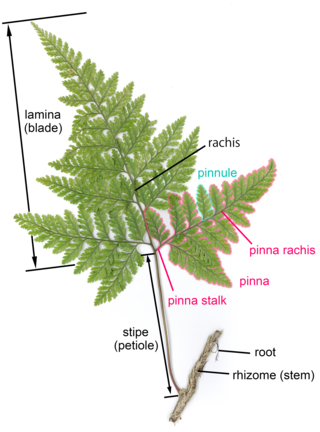
A frond is a large, divided leaf. In both common usage and botanical nomenclature, the leaves of ferns are referred to as fronds and some botanists restrict the term to this group. Other botanists allow the term frond to also apply to the large leaves of cycads, as well as palms (Arecaceae) and various other flowering plants, such as mimosa or sumac. "Frond" is commonly used to identify a large, compound leaf, but if the term is used botanically to refer to the leaves of ferns and algae it may be applied to smaller and undivided leaves.
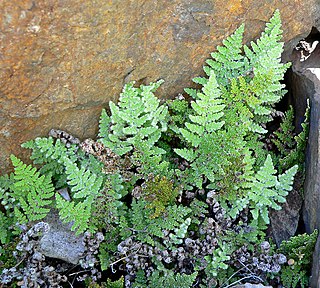
Myriopteris covillei, formerly known as Cheilanthes covillei, is a species of cheilanthoid fern known by the common name Coville's lip fern. Coville's lip fern is native to the southwestern United States and Mexico.

Cystopteris is a genus of ferns in the family Cystopteridaceae. These are known generally as bladderferns or fragile ferns. They grow in temperate areas worldwide. This is a very diverse genus and within a species individuals can look quite different, especially in harsh environments where stress stunts their growth. They hybridize easily with each other and identifying an individual can be challenging. In general these are rhizomatous perennials which grow in rocks or soil. Their leaves are multiply pinnate, in that each leaflet is divided into smaller parts. The sori are usually rounded and covered in an inflated bladder-like indusium.

Cystopteris fragilis is a species of perennial fern known by the common names brittle bladder-fern and common fragile fern. It can be found worldwide, generally in shady, moist areas.
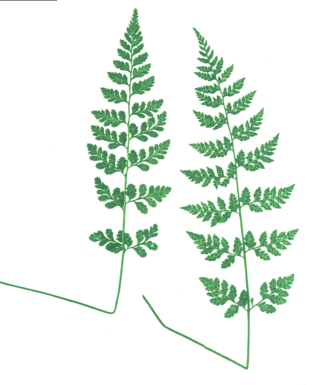
Cystopteris protrusa is a common fern of North America, commonly known as the lowland bladderfern, lowland brittle fern or lowland fragile fern.

Cystopteris bulbifera, with the common name bulblet fern, bulblet bladderfern, or bulblet fragile fern is a fern in the family Cystopteridaceae.
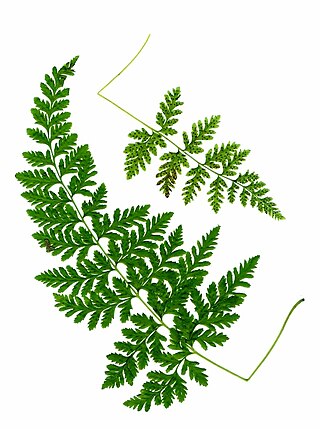
Cystopteris tenuis is sometimes known as Mackay's bladder fern or Mackay's fragile fern. It was long considered to be a part of the superspecies for fragile ferns, as Cystopteris fragilis(L.) Bernh. var. mackayiLawson.

Cystopteris montana, previously classified as Athyrium montanum, is a species of fern known by the common name mountain bladderfern. It occurs throughout the high latitudes of the Northern Hemisphere, in Eurasia, Greenland, and Alaska, and throughout Canada. It is also present in the higher elevations in Colorado farther south.
Physematium neomexicanum, the New Mexican cliff fern, is a fern species native to the Southwestern United States and northern Mexico.

Polypodium is a genus of ferns in the family Polypodiaceae, subfamily Polypodioideae, according to the Pteridophyte Phylogeny Group classification of 2016 (PPG I). The genus is widely distributed throughout the world, with the highest species diversity in the tropics. The name is derived from Ancient Greek poly ("many") + podion, on account of the foot-like appearance of the rhizome and its branches. They are commonly called polypodies or rockcap ferns, but for many species unique vernacular names exist.
Myriopteris aemula, the Texas lip fern or rival lip fern, is a moderately-sized fern of Texas and Mexico, a member of the family Pteridaceae. Unlike many members of its genus, its leaves have a few hairs on upper and lower surfaces, or lack them entirely. One of the cheilanthoid ferns, it was usually classified in the genus Cheilanthes as Cheilanthes aemula until 2013, when the genus Myriopteris was again recognized as separate from Cheilanthes. It typically grows on limestone rock.

Argyrochosma peninsularis is a fern endemic to Baja California Sur. It grows in dry, rocky places. First described as a species in 1939, it was transferred to the new genus Argyrochosma in 1987, recognizing their distinctness from the "cloak ferns". A dusting of powdery material and the presence of occasional scales on the central axis of its leaves help distinguish it from related species.
Argyrochosma pallens is a fern endemic to Mexico. It has narrow, divided leaves with brown axes; the leaves are dusted with white powder above and coated in it below. First described as a species in 1956, it was transferred to the new genus Argyrochosma in 1987, recognizing their distinctness from the "cloak ferns".
Argyrochosma lumholtzii is a rare fern in the family Pteridaceae known from Sonora, Mexico. It is quite similar to Jones' false cloak fern, but has black leaf axes and a less highly divided leaf. First described as a species in 1939, honoring the explorer Carl Sofus Lumholtz, it was transferred to the new genus Argyrochosma in 1987, recognizing their distinctness from the "cloak ferns".

Myriopteris rawsonii, formerly known as Cheilanthes rawsonii, is a perennial fern native to Namaqualand in Southern Africa. Like many other cheilanthoid ferns, it is adapted to dry conditions, bearing a thick layer of pale hairs on the underside of its pinnate-pinnatifid leaves. It is the only African representative of its clade of cheilanthoids, the otherwise American genus Myriopteris. It spends much of the year in a dried-out, dormant state, rehydrating and putting out new growth during winter rains. Its name honors the botanist and civil servant Sir Rawson W. Rawson.

Gymnocarpium disjunctum is a species of fern in the family Cystopteridaceae, commonly known as Pacific oak fern, western oak fern, or Pacific oakfern.

Myriopteris scabra, commonly known as rough lipfern, is a species of cheilanthoid fern native to Mexico and the south-western United States (Texas).

Myriopteris wrightii, formerly known as Cheilanthes wrightii, is a species of cheilanthoid fern with the common name Wright's lipfern. It is native to the southwestern United States and northern Mexico.
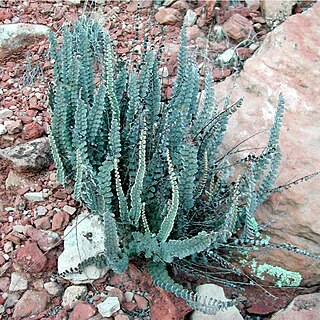
Astrolepis integerrima is a fern in the family Pteridaceae known by the common names hybrid cloakfern and southwest cloakfern. Though widespread through much of northern Mexico and parts of the southwestern and south central United States, it is nowhere common. It is only found on calcareous rocks, cliffs, and canyons in the deserts and similarly dry habitats. Astrolepis integerrima is an allotriploid, a type of hybrid containing all or almost all the chromosones of two different species.
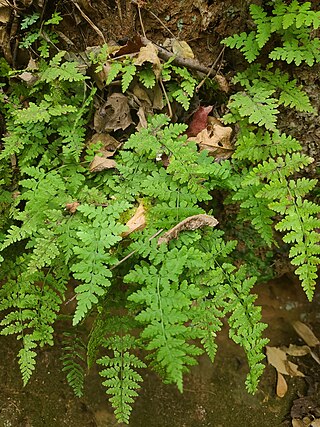
Cystopteris tennesseensis, commonly known as the Tennessee fragile fern or Tennessee bladderfern, is a species of fern in the family Cystopteridaceae.


















